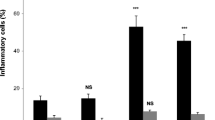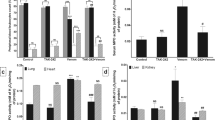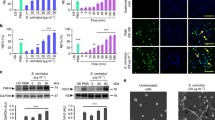Abstract
Viper envenomation results in inflammation at the bitten site as well as target organs. Neutrophils and other polymorphonuclear leukocytes execute inflammation resolving mechanism and will undergo apoptosis after completing the task. However, the target specific toxins induce neutrophil apoptosis at the bitten site and in circulation prior to their function, thus reducing their number. Circulating activated neutrophils are major source of inflammatory cytokines and leakage of reactive oxygen species (ROS)/other toxic intermediates resulting in aggravation of inflammatory response at the bitten/target site. Therefore, neutralization of venom induced neutrophil apoptosis reduces inflammation besides increasing the functional neutrophil population. Therefore, the present study investigates the venom induced perturbances in isolated human neutrophils and its neutralization by crocin (Crocus sativus) a potent antioxidant carotenoid. Human neutrophils on treatment with venom resulted in altered ROS generation, intracellular Ca2+ mobilization, mitochondrial membrane depolarization, cyt-c translocation, caspase activation, phosphatidylserine externalization and DNA damage. On the other hand significant protection against oxidative stress and apoptosis were evidenced in crocin pre-treated groups. In conclusion the viper venom induces neutrophil apoptosis and results in aggravation of inflammation and tissue damage. The present study demands the necessity of an auxiliary therapy in addition to antivenin therapy to treat secondary/overlooked complications of envenomation.







Similar content being viewed by others
References
Alam MI, Gomes A (1998) Viper venom-induced inflammation and inhibition of free radical formation by pure compound (2-hydroxy-4-methoxy benzoic acid) isolated and purified from anantimul (Hemidesmus indicus R. BR) root extract. Toxicon 36:207–215
Barja G (2002) The quantitative measurement of H2O2 generation in isolated mitochondria. J Bioenerg Biomembr 34:227–233
Ben Amor N, Pariente JA, Salido GM, Bartegi A, Rosado JA (2006) Caspases 3 and 9 are translocated to the cytoskeleton and activated by thrombin in human platelets. Evidence for the involvement of PKC and the actin filament polymerization. Cell Signal 18:1252–1261
Bradley PP, Christensen RD, Rothstein G (1982) Cellular and extracellular myeloperoxidase in pyogenic inflammation. Blood 60:618–622
Brenes O, Munoz E, Roldan-Rodriguez R, Diaz C (2010) Cell death induced by Bothrops asper snake venom metalloproteinase on endothelial and other cell lines. Exp Mol Pathol 88:424–432
Clissa PB, Lopes-Ferreira M, Della-Casa MS, Farsky SH, Moura-da-Silva AM (2006) Importance of jararhagin disintegrin-like and cysteine-rich domains in the early events of local inflammatory response. Toxicon 47:591–596
Coelho AL, De Freitas MS, Mariano-Oliveira A, Rapozo DC, Pinto LF, Niewiarowski S, Zingali RB, Marcinkiewicz C, Barja-Fidalgo C (2004) RGD- and MLD-disintegrins, jarastatin and EC3, activate integrin-mediated signaling modulating the human neutrophils chemotaxis, apoptosis and IL-8 gene expression. Exp Cell Res 292:371–384
Dalli J, Serhan CN (2012) Specific lipid mediator signatures of human phagocytes: microparticles stimulate macrophage efferocytosis and pro-resolving mediators. Blood 120:60–72
Danial NN, Korsmeyer SJ (2004) Cell death: critical control points. Cell 116:205–219
De Souza CA, Kayano AM, Setubal SS, Pontes AS, Furtado JL, Kwasniewski FH, Zaqueo KD, Soares AM, Stábeli RG, Zuliani JP (2012) Local and systemic biochemical alterations induced by Bothrops atrox snake venom in mice. J Venom Res 3:28–34
Díaz C, Valverde L, Brenes O, Rucavado A, Gutiérrez JM (2005) Characterization of events associated with apoptosis/anoikis induced by snake venom metalloproteinase BaP1 on human endothelial cells. J Cell Biochem 94:520–528
Driver AS, Kodavanti PS, Mundy WR (2000) Age related changes in reactive oxygen species production in rat brain homogenates. Neurotoxicol Teratol 22:175–181
El Kebir D, Gjorstrup P, Filep JG (2012) Resolvin E1 promotes phagocytosis-induced neutrophil apoptosis and accelerates resolution of pulmonary inflammation. Proc Natl Acad Sci USA 109:14983–14988
Girish KS, Kemparaju K (2011) Overlooked issues of snakebite management: time for strategic approach. Curr Top Med Chem 11:2494–2508
Hsieh CL, Yan GC (2000) Antioxidant actions of du-zhong (Eucommia ulmoides Oliv.) toward oxidative damage in biomolecules. Life Sci 66:1387–1400
Jardin I, Ben Amor N, Bartegi A, Pariente JA, Salido GM, Rosado JA (2007) Differential involvement of thrombin receptors in Ca2+ release from two different intracellular stores in human platelets. Biochem J 401:167–174
Kumar D, Lou H, Singal PK (2002) Oxidative stress and apoptosis in heart dysfunction. Herz 27:662–668
Lalloo D, Theakston DG (2003) Snake antivenoms. J Toxicol Clin Toxicol 41:277–290
Leon G, Valverde JM, Rojas G, Lomonte B, Gutierrez JM (2000) Comparative study on the ability of IgG and Fab sheep anti-venoms to neutralize local hemorrhage, edema and myonecrosis induced by Bothrops asper (terciopelo) snake venom. Toxicon 38:233–244
Liu WH, Chang LS (2009) Reactive oxygen species and p38 mitogen-activated protein kinase induce apoptotic death of U937 cells in response to Naja nigricollis toxin-gamma. J Cell Mol Med 13:1695–1705
Lopez JJ, Salido GM, Pariente JA, Rosado JA (2006) Interaction of STIM1 with endogenously expressed human canonical TRP1 upon depletion of intracellular Ca2+ stores. J Biol Chem 281:28254–28264
Lopez JJ, Salido GM, Gómez-Arteta E, Rosado JA, Pariente JA (2007) Thrombin induces apoptotic events through the generation of reactive oxygen species in human platelets. J Thromb Haemost 5:1283–1291
Lowry OH, Rosebrough NJ, Farr AL, Randall RJ (1951) Protein measurement using folin-phenol reagent. J Biol Chem 193:265–275
Luo HR, Loison F (2008) Constitutive neutrophil apoptosis: mechanisms and regulation. Am J Hematol 83:288–295
Michlewska S, Dransfield I, Megson IL, Rossi AG (2009) Macrophage phagocytosis of apoptotic neutrophils is critically regulated by the opposing actions of pro-inflammatory and anti-inflammatory agents: key role for TNF-alpha. FASEB J 23:844–854
Montalvo-Hernández B, Rito-Palomares M, Benavides J (2012) Recovery of crocins from saffron stigmas (Crocus sativus) in aqueous two-phase systems. J Chromatogr A 1236:7–15
Moreira V, Dos-Santos MC, Nascimento NG, Borges da Silva H, Fernandes CM, D’Império Lima MR, Teixeira C (2012) Local inflammatory events induced by Bothrops atrox snake venom and the release of distinct classes of inflammatory mediators. Toxicon 60:12–20
Mukherjee AK, Maity CR (1997) Effect of dietary supplementation of vitamin E in partial inhibition of Russell’s viper venom phospholipase A2 induced hepatocellular and microsomal membrane damage in rats. Acta Physiol Hung 85(4):367–374
Murakami T, Kamikado N, Fujimoto R, Hamaguchi K, Nakamura H, Chijiwa T, Ohno M, Oda-Ueda N (2011) A [Lys49] phospholipase A2 from Protobothrops flavoviridis venom induces caspase-independent apoptotic cell death accompanied by rapid plasma-membrane rupture in human leukemia cells. Biosci Biotechnol Biochem 75:864–870
Ohkawa H, Ohnishi N, Yagi K (1979) Assay for lipid peroxides in animal tissues by thiobarbituricacid reaction. Anal Biochem 95:351–358
Park MH, Jo MR, Won D, Song HS, Han SB, Song MJ, Hong JT (2012) Snake venom toxin from Vipera lebetina turanica induces apoptosis in colon cancer cells via upregulation of ROS- and JNK-mediated death receptor expression. BMC Cancer 12:228
Rosado JA, Graves D, Sage SO (2000) Tyrosine kinases activate store-mediated Ca2+ entry in human platelets through the reorganization of the actin cytoskeleton. Biochem J 351:429–437
Salvioli S, Ardizzoni A, Franceschi C, Cossarizza A (1997) JC-1, but not DiOC6(3) or rhodamine 123, is a reliable fluorescent probe to assess delta psi changes in intact cells: implications for studies on mitochondrial functionality during apoptosis. FEBS Lett 411:77–82
Santhosh MS, Sundaram MS, Sunitha K, Kemparaju K, Girish KS (2013a) Viper venom-induced oxidative stress and activation of inflammatory cytokines: a therapeutic approach for overlooked issues of snakebite management. Inflamm Res 62:721–731
Santhosh MS, Thushara RM, Hemshekhar M, Sunitha K, Devaraja S, Kemparaju K, Girish KS (2013b) Alleviation of viper venom induced platelet apoptosis by crocin (Crocus sativus): implications for thrombocytopenia in viper bites. J Thromb Thrombolysis 36:424–432
Sebastin Santhosh M, Hemshekhar M, Thushara RM, Devaraja S, Kemparaju K, Girish KS (2013) Vipera russelli venom induced oxidative stress and hematological alterations: amelioration by crocin a dietary colorant. Cell Biochem Funct 31:41–50
Setubal Sda S, Pontes AS, Nery NM, Bastos JS, Castro OB, Pires WL, Zaqueo KD et al (2013) Effect of Bothrops bilineata snake venom on neutrophil function. Toxicon 76:143–149
Setubal SS, Pontes AS, Furtado JL, Kayano AM, Stabeli RG, Zuliani JP (2011) Effect of Bothrops alternatus snake venom on macrophage phagocytosis and superoxide production: participation of protein kinase C. J Venom Anim Toxins Incl Trop Dis 17:430–441
Singh NP, McCoy T, Tice RR, Schneider EL (1988) A simple technique for quantitation of low levels of DNA damage in individual cells. Exp Cell Res 175:184–192
Singh M, Sharma H, Singh N (2007) Hydrogen peroxide induces apoptosis in HeLa cells through mitochondrial pathway. Mitochondrion 7:367–373
Teixeira Cde F, Fernandes CM, Zuliani JP, Zamuner SF (2005) Inflammatory effects of snake venom metalloproteinases. Mem Inst Oswaldo Cruz 1:181–184
Teklemariam T, Seoane AI, Ramos CJ, Sanchez EE, Lucena SE, Perez JC, Mandal SA, Soto JG (2011) Functional analysis of a recombinant PIII-SVMP, GST-acocostatin; an apoptotic inducer of HUVEC and HeLa, but not SK-Mel-28 cells. Toxicon 57:646–656
Torii S, Naito M, Tsuruo T (1997) Apoxin I, a novel apoptosis-inducing factor with L-amino acid oxidase activity purified from Western diamondback rattlesnake venom. J Biol Chem 272:9539–9542
Tsai IH, Lu PJ, Su JC (1996) Two types of Russell’s viper revealed by variation in phospholipases A2 from venom of the subspecies. Toxicon 4:99–109
Ushanandini S, Nagaraju S, Harish Kumar K, Vedavathi M, Machiah DK, Kemparaju K, Vishwanath BS, Gowda TV, Girish KS (2006) The anti-snake venom properties of Tamarindus indica (Leguminosae) seed extract. Phytother Res 20:851–858
Valko M, Leibfritz D, Moncol J, Cronin MT, Mazur M, Telser J (2007) Free radicals and antioxidants in normal physiological functions and human disease. Int J Biochem Cell Biol 39:44–84
Wei JF, Wei XL, Chen QY, He SH (2010) Induction of inflammatory cell accumulation by TM-N49 and promutoxin, two novel phospholipase A(2). Toxicon 56:580–588
Yamaguchi T, Takamura H, Matoba T, Terao J (1998) HPLC method for evaluation of the free radical-scavenging activity of foods by using 1,1-diphenyl-2-picrylhydrazyl. Biosci Biotechnol Biochem 62:1201–1204
Zamuner SR, Zuliani JP, Fernandes CM, Gutiérrez JM, de Fátima Pereira Teixeira C (2005) Inflammation induced by Bothrops asper venom: release of proinflammatory cytokines and eicosanoids, and role of adhesion molecules in leukocyte infiltration. Toxicon 46:806–813
Zhu L, Yuan C, Chen Z, Wang W, Huang M (2010) Expression, purification and characterization of recombinant Jerdonitin, a P-II class snake venom metalloproteinase comprising metalloproteinase and disintegrin domains. Toxicon 55:375–380
Acknowledgements
S.S.M thanks the Council of Scientific and Industrial Research (CSIR), Government of India, New Delhi, India, for financial assistance (SRF-Ref: 9/119(0191)2K12EMR-I Dated 28-02-2012). Authors thank Central Instrumentation Facility, University of Mysore, Institute of Excellence Project (IOE), MHRD, Government of India.
Conflict of interest
The authors declare that there are no conflicts of interest.
Author information
Authors and Affiliations
Corresponding author
Rights and permissions
About this article
Cite this article
Santhosh, M.S., Sundaram, M.S., Sunitha, K. et al. Propensity of crocin to offset Vipera russelli venom induced oxidative stress mediated neutrophil apoptosis: a biochemical insight. Cytotechnology 68, 73–85 (2016). https://doi.org/10.1007/s10616-014-9752-x
Received:
Accepted:
Published:
Issue Date:
DOI: https://doi.org/10.1007/s10616-014-9752-x




